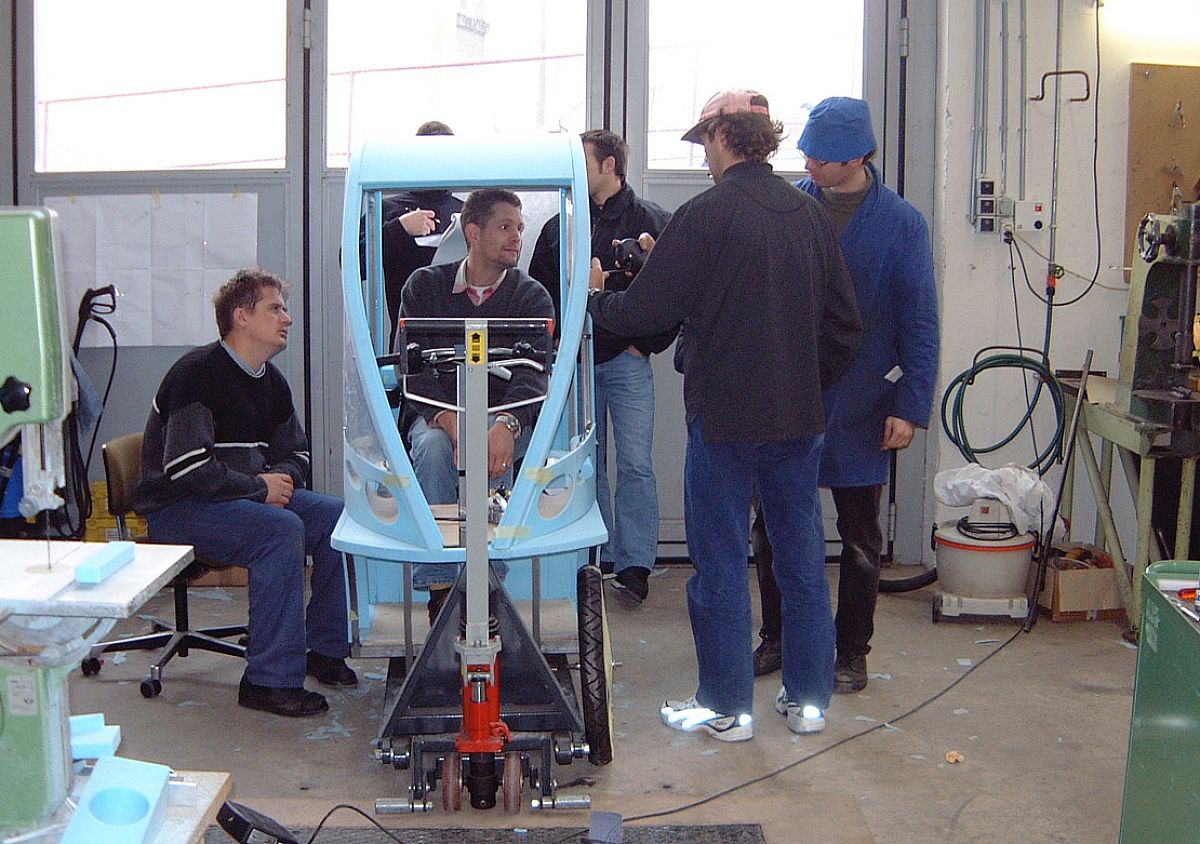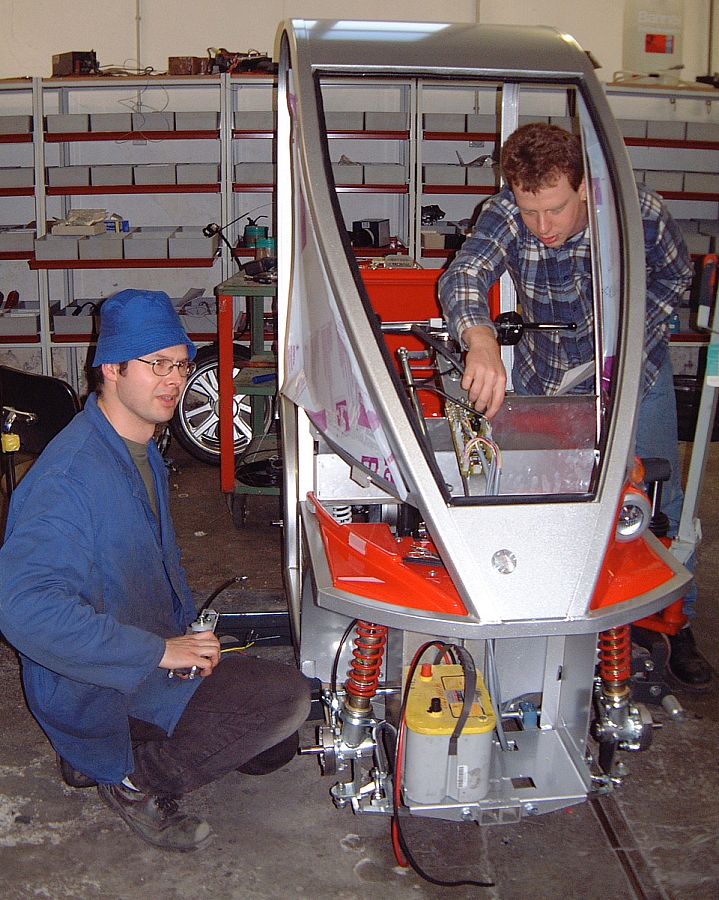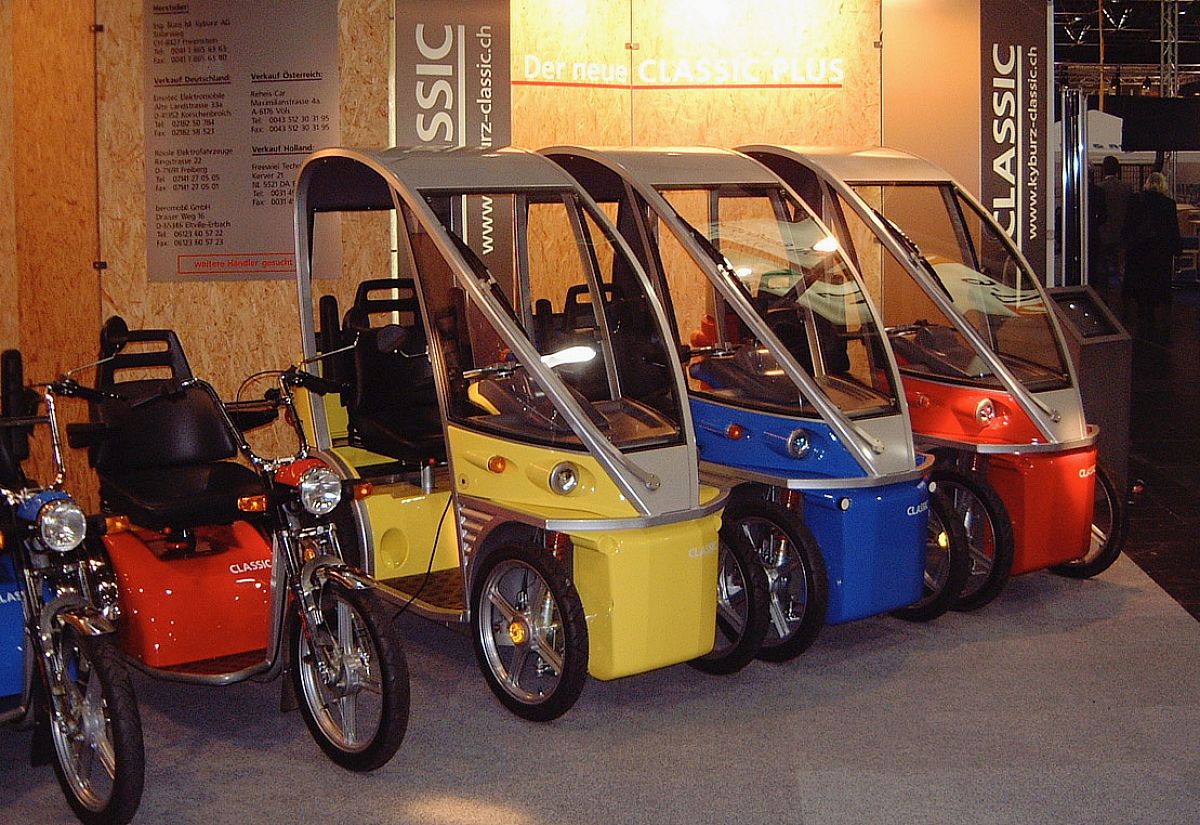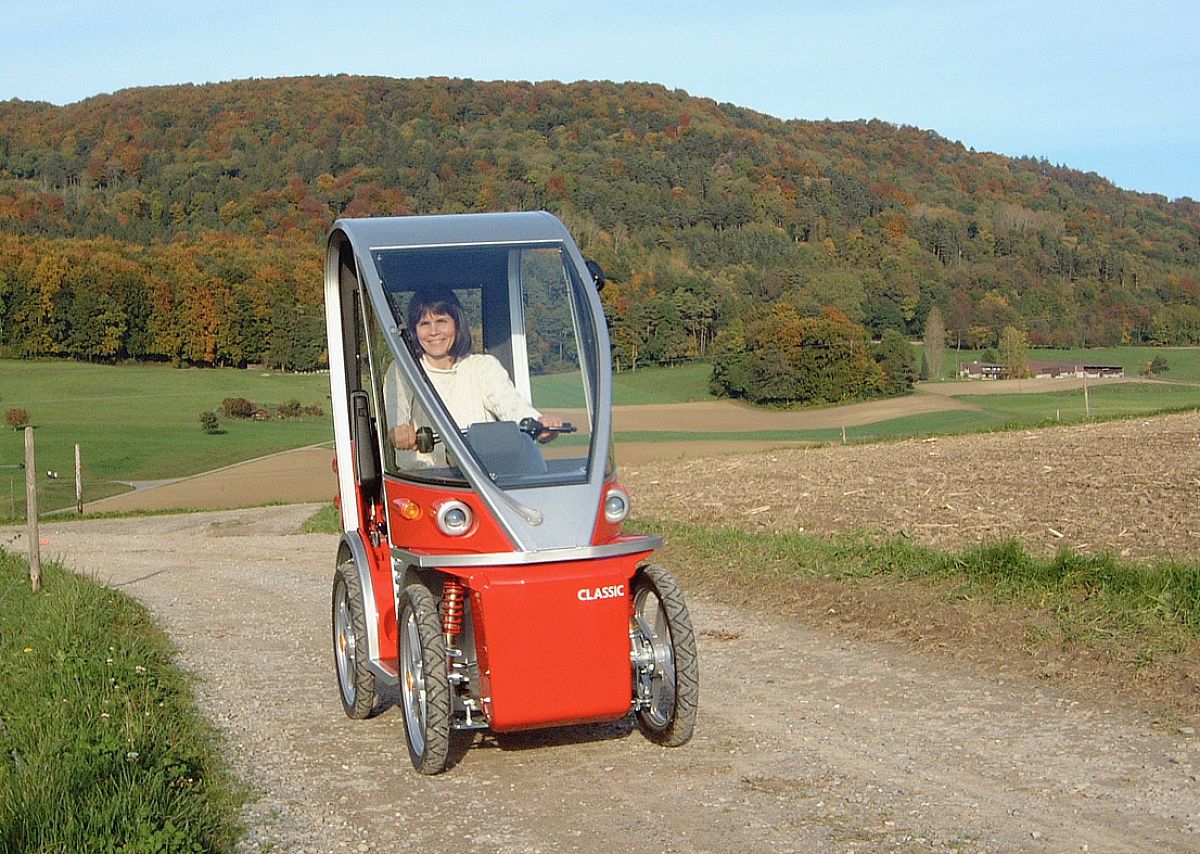The CLASSIC PLUS is created

Stefan Rittler came back from his holidays. He asked me if I could pick him up at the airport, which of course I did. It was a very special holiday: Stefan had married his bride named Alima in Nigeria. She had to stay in Nigeria for a few more weeks until she got her visa to travel to Switzerland. Stefan came back alone for the time being. When I picked Stefan up, he was off like a shot: He had an idea for a new project! A four-wheeler with a cabin. And already he sketched his thoughts on a piece of paper. The rough concept of a four-wheeled cabin vehicle was born. The proportions of a vehicle were defined, the individual components were arranged and the approximate weight distribution could be estimated. In addition, people of different sizes were used and the ergonomics could be assessed. What was special about Stefan's design was that the batteries were placed in the front area, between the steered wheels. This would result in an optimal weight distribution of 50% on the front axle and 50% on the rear axle. He had also already sketched the steering construction and the suspension and the drive was defined. "Aha? And how was it on your honeymoon?" I wanted to know. Yes, very nice. In Nigeria, he said, it was the custom that immediately after the wedding, the bride and groom were put in a nice hotel and locked up for 10 days. Nine months later, the family was expecting offspring. During these 10 days, among other things, the basic design of the new project was created, later called the CLASSIC PLUS. So far so good. I was convinced by Stefan's approach. What we needed was a designer. I had some money put aside, and if we started this new project, we could raise a decent amount of money for the development. Stefan immediately started to transform his plans for the seat box into a metal construction while I pondered over the designer. Stefan told me that some time ago someone had passed through our company who had introduced himself as a designer, but he no longer had his address. That didn't help much, and I asked Stefan to look for the address in his collection of notes. Two weeks later, he came to me full of joy with a business card. It said: Daniel Johner with an address in Freienstein. The next morning, a Saturday, I called the number and a Mr. Johner answered. I explained the situation to him and that we needed a talented designer for our new project because the task was very challenging. Dani said he had just got off the plane coming from New Zealand, and before he unpacked his suitcase, he would drop in for a visit, we were practically neighbours. I told him to please take one of his projects with him to show me how he worked. Dani came in the door with a toolbox. He put it on the table and opened it. He had constructed and designed it especially for the technicians of Swissair Technics. It took up a minimum of floor space and with one swivel, the complete tools are accessible in three working areas. I was convinced and offered Dani the job of designing the new vehicle. We agreed on a sum and a time of about a year in which the project should be realized. Less than 8 hours after getting off the plane in Switzerland, he had a job. Later, Dani told me that he had started the journey to Switzerland in New Zealand because he had felt a strong desire to design an electric car. Who had called whom?
At first, the collaboration went very well. Stefan designed, Dani researched, sketched, calculated and tested. Reams of paper were processed while Stefan optimized his chassis. Soon the first test drives could be made with the empty frame. The results were promising. I was responsible for the planning and set the milestones. Occasionally, we presented development milestones to our staff and involved our salespeople in the process. Dani put some styrofoam blocks on the first drivable chassis and carved the first design model out of them.

Among other things, we also took this to Germany so that our European resellers could have a look. We made very good progress and I was overjoyed. Soon we were able to have a special extrusion drawn for us, with which we were able to produce some initial chassis. What was still missing were all the plastic parts. For this we went together to a supplier in the Czech Republic. Together we made the master moulds, drew the negative moulds, and finally held the first set of plastic parts in our hands. It was a very intensive time. The longer the collaboration went on, the more differences built up between Stefan, the designer, and Dani, the designer. While Stefan was aiming for very pragmatic solutions that above all allowed for the cheapest possible construction and easy maintenance, Dani was very concerned about ergonomics and proportions. More and more often I found myself having to play referee and take sides with one side or the other. Stefan complained because he couldn't get involved enough. This was to be bitterly avenged later. Nevertheless, the project was completed and we set up three vehicles to present at the Rehacare trade show in Düsseldorf.

The curiosity was great and various special interest groups contacted us in advance to be present at the show. Someone from the press also contacted us and Lukas, our sales manager, happened to be on the phone. He raved about the new project. The PLUS is a completely new vehicle. It is so sophisticated that even blind people can drive it. The press representative was interested. "Blind people drive cars?" There had never been anything like that before. He wanted to come to Rehacare and see it with his own eyes. Lukas had hardly hung up the phone when I confronted him. "What? What were you thinking. How on earth are blind people going to be able to ride the PLUS...?" Luke was dismayed. The reporter had annoyed him, and he had lost his temper. The phone rang again. The editor of the newspaper was on the line. There would be a big report, they wanted to broadcast it on their TV station. Lukas hung up: we were on the hook. What should we do now? Only a few weeks until the fair and according to Lukas' information a blind man should be able to drive the PLUS? We immediately called Stefan into the office and the newly hired young mechatronics engineer Frank Loacker: crisis meeting! Lukas had told a reporter that the PLUS was so good that blind people could drive it. What are we going to do now?
Frank told us about a project at his former employer. There he had built a vehicle that could follow a magnetic strip by means of sensors. That could be one way. We discussed, sketched and calculated. At the end of the day, we had a plan. We got magnetic strips that we could use to lay a track on the ground. Frank constructed a sensor system that could detect the position of this magnetic strip and also detect the deviation from the centre line. By means of two vibrators built into the handlebars, we wanted to signal to the driver whether he should steer more to the right or more to the left in order to stay on track. I knew from my previous employment of ultrasonic sensors that sensed the space in front of the vehicle and could signal in the event of an obstacle to automatically initiate deceleration or emergency braking. This could work! We put our heads together to make this project a reality. Since there were too few of us, we asked around in our environment and even our Austrian reseller Roland Reheis came to help us. He knew a lot about analogue technology, which we could use for this project.
In Düsseldorf, we organized a blind driver to arrive just before the press conference. The project was finished so tightly that we couldn't test it before the fair started. We set up the track, the blind man sat in the vehicle, and we explained the function to him. I shivered as he carefully drove off. Tentatively at first, then faster and faster, he turned the circles. It worked! A blind man was driving our PLUS! The press people were thrilled. We received several reports, even the German news reported about our invention. This in turn prompted many blind people to come to our stand to test the vehicle with which they could possibly get around independently in the future. Unfortunately, we had to tell everyone that they could test the PLUS on our circuit at the fair. However, it was out of the question that they would be able to manage their way to work independently in the near future. Despite our success, this fair was bitter for me. We had to disappoint many people. Despite a successful presentation of the PLUS, I was in a very bad mood: we had promised something that we could not deliver as such. Eighteen years later, our research team picked up the ball again. The sensor technology had improved enormously, and the computers had become much more powerful. Today, on the basis of the PLUS, we are actually working on a project that will enable the first blind driver to make her way to work independently. If we succeed in this project, I will be able to keep the promise we made back then, almost twenty years later.
I had an amazing experience at this fair: A young blind man came to our stand and wanted to drive the PLUS. He mastered the vehicle and drove around the circuit exceptionally fast. Afterwards he wanted to drive the open CLASSIC, which I refused at first, as the CLASSIC was not equipped with the sensor system. He calmed me down and wanted to drive anyway. Incredulous, I brought him the vehicle, and he sat down. To my complete surprise, he drove. Carefully, but firmly, the same lap off. He curved past parked cars and fences and was able to get his bearings.

I wanted to know how he did it, and he told me that he made clicking sounds all the time. With a little practice, he said, you could hear the echo and thus notice whether an object was in front of you or not. With his clicking sound technique, he could actually move our CLASSIC safely. He was overjoyed at the chance he had been given to drive a vehicle, and I had learned a lot again.
I learned from it:
- If the time and place are right, new concepts emerge, even on the honeymoon.
- If someone goes too far, a good team helps to master the situation.
- Some of my projects take a really long time, even up to 20 years.
